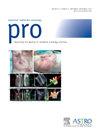利用多标准优化进行功能性肺避让规划
IF 3.4
3区 医学
Q2 ONCOLOGY
引用次数: 0
摘要
肺功能回避(FLA)放射治疗是一个不断发展的领域。功能性肺回避计划的目的是减少功能性肺区域的剂量,同时目标覆盖范围和危险器官的剂量相当。多标准优化(MCO)是一种可协助FLA计划的计划工具。本研究评估了使用 MCO 调整放疗计划以避开使用 68Ga-4D-V/Q PET/CT 确定的肺功能区的可行性。方法 进行了一项前瞻性临床试验[匿名以供审查],患者在放疗前接受了 68Ga-4D-V/Q PET/CT 检查。在 72 名参加该试验的患者中,38 名患者为 III 期非小细胞肺癌,有资格被选入该计划研究。肺功能靶体积 HF 肺(高功能肺)和 F 肺(功能肺)是通过通气肺和灌注肺来定义的。利用基于知识的计划,创建了一个基线解剖计划,然后利用多标准优化生成了一个功能调整计划。主要目的是减少高频肺的剂量。临床医生使用 MCO 工具选择最终的 FLA 计划。使用标准统计方法对功能性肺的剂量、目标体积、风险器官和计划质量进行比较。结果 所有患者的高频肺容积都被成功切除。在 38 名患者中,有 36 名患者成功保留了功能肺容积。解剖学定义的危险器官的剂量没有明显的临床差异。规划目标容积(PTV)在最大剂量和最小剂量附近存在差异。在所有患者中,肺功能平均剂量有显著的统计学降低,但接受20 Gy剂量的功能体积却没有显著降低。所有权衡决定均由临床医生做出。结论 在 FLA 中使用 MCO 是可行的,但会导致 PTV 覆盖范围发生变化。使用 MCO 的一个明显优势是,有关 FLA 成本和效益的所有决定都可以实时做出。本文章由计算机程序翻译,如有差异,请以英文原文为准。
Functional Lung Avoidance Planning Using Multicriteria Optimization
Purpose
Functional lung avoidance (FLA) radiation therapy is an evolving field. The aim of FLA planning is to reduce dose to areas of functioning lung, with comparable target coverage and dose to organs at risk. Multicriteria optimization (MCO) is a planning tool that may assist with FLA planning. This study assessed the feasibility of using MCO to adapt radiation therapy plans to avoid functional regions of lung that were identified using a 68Ga-4D-V/Q positron emission tomography/computed tomography.
Methods and Materials
A prospective clinical trial U1111-1138-4421 was performed in which patients had a 68Ga-4D-V/Q positron emission tomography/computed tomography before radiation treatment. Of the 72 patients enrolled in this trial, 38 patients had stage III non-small cell lung cancer and were eligible for selection into this planning study. Functional lung target volumes HF lung (highly functioning lung) and F lung (functional lung) were defined using the ventilated and perfused lung. Using knowledge-based planning, a baseline anatomic plan was created, and then a functional adapted plan was generated using multicriteria optimization. The primary aim was to spare dose to HF lung. Using the MCO tools, a clinician selected the final FLA plan. Dose to functional lung, target volumes, organs at risk and measures of plan quality were compared using standard statistical methods.
Results
The HF lung volume was successfully spared in all patients. The F lung volume was successfully spared in 36 of the 38 patients. There were no clinically significant differences in dose to anatomically defined organs at risk. There were differences in the planning target volume near maximum and minimum doses. Across the entire population, there was a statistically significant reduction in the functional mean lung dose but not in the functional volume receiving 20 Gy. All trade-off decisions were made by the clinician.
Conclusions
Using MCO for FLA was achievable but did result in changes to planning target volume coverage. A distinct advantage in using MCO was that all decisions regarding the cost and benefits of FLA could be made in real time.
求助全文
通过发布文献求助,成功后即可免费获取论文全文。
去求助
来源期刊

Practical Radiation Oncology
Medicine-Radiology, Nuclear Medicine and Imaging
CiteScore
5.20
自引率
6.10%
发文量
177
审稿时长
34 days
期刊介绍:
The overarching mission of Practical Radiation Oncology is to improve the quality of radiation oncology practice. PRO''s purpose is to document the state of current practice, providing background for those in training and continuing education for practitioners, through discussion and illustration of new techniques, evaluation of current practices, and publication of case reports. PRO strives to provide its readers content that emphasizes knowledge "with a purpose." The content of PRO includes:
Original articles focusing on patient safety, quality measurement, or quality improvement initiatives
Original articles focusing on imaging, contouring, target delineation, simulation, treatment planning, immobilization, organ motion, and other practical issues
ASTRO guidelines, position papers, and consensus statements
Essays that highlight enriching personal experiences in caring for cancer patients and their families.
 求助内容:
求助内容: 应助结果提醒方式:
应助结果提醒方式:


